Mechanical and Acoustic Properties of Alloys Used for Musical Instruments
Abstract
:1. Introduction
2. Materials and Methods
2.1. Materials
2.2. Characterization Techniques
2.2.1. Tensile Test
2.2.2. Intrinsic Transfer Matrix
2.2.3. Scanning Electron Microscopy (SEM) and Energy-Dispersive X-ray Spectroscopy (EDX) Analysis
2.2.4. Simulation of Modal Analysis of Triangles
3. Results and Discussion
3.1. Tensile Test (TT)
3.2. Intrinsic Transfer Matrix Method (ITMM)
3.3. Scanning Electron Microscopy (SEM) and Energy-Dispersive X-ray Spectroscopy (EDX) Analysis
3.4. Modal Analysis of Triangles
4. Conclusions
- Identification of the elastic, acoustic and morphological properties of the materials used in the construction of musical triangles;
- Convergence of the experimental results obtained by the two methods, with an error of less than 5%;
- Chemical and morphological analysis confirmed the ductile and brittle fracture pattern of the aluminum and stainless steel materials, respectively;
- According to the mechanical and acoustic test results, the aluminum-based musical triangle could be used by players for high crystalline sound, while the stainless steel musical triangle could be used when lower frequencies are required.
Author Contributions
Funding
Institutional Review Board Statement
Informed Consent Statement
Data Availability Statement
Acknowledgments
Conflicts of Interest
References
- Yekefallah, L.; Namdar, P.; Azimian, J.; Mohammadi, S.D.; Mafi, M. The effects of musical stimulation on the level of consciousness among patients with head trauma hospitalized in intensive care units: A randomized control trial. Complementary Ther. Clin. Pract. 2021, 42, 101258, ISSN 1744-3881. [Google Scholar] [CrossRef] [PubMed]
- Pauwels, E.K.; Volterrani, D.; Mariani, G.; Kostkiewics, M. Mozart, music and medicine. Med. Princ. Pract. 2014, 23, 403–412. [Google Scholar] [CrossRef] [PubMed]
- Galińska, E. Music therapy in neurological rehabilitation settings. Psychiatr. Pol. 2015, 49, 835–846. [Google Scholar] [CrossRef] [PubMed]
- Stanciu, M.D.; Nastac, S.M.; Bucur, V.; Trandafir, M.; Dron, G.; Nauncef, A.M. Dynamic Analysis of the Musical Triangles—Experimental and Numerical Approaches. Appl. Sci. 2022, 12, 6275. [Google Scholar] [CrossRef]
- Bucur, V. Handbook of Materials for Percussion Musical Instruments; Springer: Berlin/Heidelberg, Germany, 2022. [Google Scholar]
- East, S. Science: A Model and a Metaphor in the Work of Four British Composers. Sydney Conservatorium of Music. Master’s Thesis, University of Sydney, Sydney, Australia, 2005. [Google Scholar]
- Fletcher, N.H. Tuning a Pentangle—A new musical vibrating element. Appl. Acoust. 1993, 39, 145–163. [Google Scholar] [CrossRef] [Green Version]
- Fletcher, N.H.; Henderson, M. A Tuned Percussion Instrument of Novel Design, the Pentangle. Australian Patent EP0630511A1, 28 December 1994. Available online: https://patents.google.com/patent/EP0630511A1/en (accessed on 28 April 2021).
- Legge, K.A. Non-Linear Mode Coupling in Symmetrically Kinked Bars. J. Sound Vib. 1987, 118, 23–34. [Google Scholar] [CrossRef] [Green Version]
- Blades, J. PERCUSSION Instruments and Their History; Faber and Faber: London, UK, 1974. [Google Scholar]
- Rossing, T.D. Acoustics of percussion instruments. Phys. Teach. 1976, 14, 546–556. [Google Scholar] [CrossRef]
- Bestle, P.; Hanss, M.; Eberhard, P. Experimental and numerical analysis of the musical behavior of triangle instruments. In Proceedings of the 5th European Conference of Computational Mechanics (ECCM V), Barcelona, Spain, 20–25 July 2014; pp. 3104–3114. [Google Scholar]
- Bucur, V. Handbook of Materials for String Musical Instruments; Chapter 3-Mechanical characterization of materials for string instruments; Springer: Berlin/Heidelberg, Germany, 2016; pp. 93–132. [Google Scholar]
- Gough, C. Handbook of Acoustics, Chapter 15; Musical Acoustics; TD Rossing; Springer: Berlin/Heidelberg, Germany, 2006; pp. 533–667. [Google Scholar]
- Dunlop, J.I. Flexural vibrations of the triangle. Acustica 1984, 55, 250–253. [Google Scholar]
- Stanciu, M.D.; Trandafir, M.; Dron, G.; Munteanu, M.V.; Bucur, V. Numerical Modal Analysis of Kinked Bars–Triangle Case of Study. In Proceedings of the 9th International Conference on Modern Manufacturing Technologies in Industrial Engineering, online, 23–26 June 2021; Modtech: Aiea, HI, USA, 2021. [Google Scholar]
- Rossing, T.D.; Fletcher, N.H. Principles of Vibration and Sound; Springer: New York, NY, USA, 2004. [Google Scholar]
- Tan, B.; Zhang, S.; Cao, X.; Fu, A.; Guo, L.; Marzouki, R.; Li, W. Insight into the anti-corrosion performance of two food flavors as eco-friendly and ultra-high performance inhibitors for copper in sulfuric acid medium. J. Colloid Interface Sci. 2022, 609, 838–851. [Google Scholar] [CrossRef]
- Tan, B.; Lan, W.; Zhang, S.; Deng, H.; Qiang, Y.; Fu, A.; Ran, Y.; Xiong, J.; Marzouki, R.; Li, W. Passiflora edulia Sims leaves Extract as renewable and degradable inhibitor for copper in sulfuric acid solution. Colloids Surf. A Physicochem. Eng. Asp. 2022, 645, 128892. [Google Scholar] [CrossRef]
- Cretu, N.; Nita, G. A simplified modal analysis based on the properties of the transfer matrix. Mech. Mater. 2013, 60, 121–128. [Google Scholar] [CrossRef]
- Cretu, N.; Pop, I.M.; Rosca, I.C. Eigenvalues and eigenvectors of the transfer matrix. AIP Conf. Proc. 2012, 1433, 535–538. [Google Scholar] [CrossRef]
- Cretu, N. Wave transmission approach based on modal analysis for embedded mechanical systems. J. Sound Vib. 2013, 332, 4940–4947. [Google Scholar] [CrossRef]
- Pop, M.I.; Cretu, N. Intrinsic transfer matrix method and split quaternion formalism for multilayer media. Wave Motion 2016, 65, 105–111. [Google Scholar] [CrossRef]
- Parrinello, A.; Ghiringhelli, G.L. Transfer matrix representation for periodic planar media. J. Sound Vib. 2016, 371, 196–209. [Google Scholar] [CrossRef]
- Rong, G.; Wenbo, T. Transfer matrix for sound attenuation in resonators with perforated intruding inlets. Appl. Acoust. 2017, 116, 14–23. [Google Scholar] [CrossRef]
- Tylek, I.; Kuchta, K. Mechanical properties of structural stainless steels. Czas. Tech. 2014, 2014, 59–80. [Google Scholar]
- Luecke, W.E.; Slotwinski, J.A. Mechanical properties of austenitic stainless steel made by additive manufacturing. J. Res. Natl. Inst. Stand. Technol. 2014, 119, 398–418. [Google Scholar] [CrossRef] [PubMed]
- Hellier, A.K.; Chaphalkar, P.P.; Prusty, B.G. Fracture Toughness Measurement for Aluminium 6061-T6 using Notched Round Bars. In Proceedings of the 9th Australasian Congress on Applied Mechanics (ACAM9), Sydney, Australia, 27–29 November 2017; pp. 332–339. [Google Scholar]
- David, R.L. (Ed.) CRC Handbook of Chemistryand Physics, Internet Version 2005; CRC Press: Boca Raton, FL, USA, 2005; Available online: https://www.academia.edu/28803942/CRC_Handbook_of_Chemistry_and_Physics_Editor_in_Chief (accessed on 19 June 2021).
- Engineering ToolBox. Young’s Modulus, Tensile Strength and Yield Strength Values for some Materials. 2003. Available online: https://www.engineeringtoolbox.com/young-modulus-d_417.html (accessed on 19 June 2021).
- Standard EN 573-3:2019. Aluminium and Aluminium Alloys. Chemical Composition and Form of Wrought Products Chemical Composition and Form of Products. Available online: https://www.en-standard.eu/bs-en-573-3-2019-aluminium-and-aluminium-alloys-chemical-composition-and-form-of-wrought-products-chemical-composition-and-form-of-products/ (accessed on 25 March 2021).
- Murakami, Y. (Ed.) 17-Martensitic Stainless Steels. In Metal Fatigue, 2nd ed.; Academic Press: Cambridge, MA, USA, 2019; pp. 431–451. [Google Scholar] [CrossRef]
- Kim, H.; Liu, Z.; Cong, W.; Zhang, H.-C. Tensile Fracture Behavior and Failure Mechanism of Additively-Manufactured AISI 4140 Low Alloy Steel by Laser Engineered Net Shaping. Materials 2017, 10, 1283. [Google Scholar] [CrossRef] [PubMed] [Green Version]
- Bayazid, M.M.; Farhangi, H.; Asgharzadeh, H.; Radan, L.; Ghahramani, A.; Mirhaji, A. Effect of cyclic solution treatment on microstructure and mechanical properties of friction stir welded 7075 Al alloy. Mater. Sci. Eng. A 2016, 649, 293–300. [Google Scholar] [CrossRef]
- Ammar, H.R.; Samuel, A.M.; Samuel, F.H.; Simielli, E.; Sigworth, G.K.; Lin, J.C. Influence of Aging Parameters on the Tensile Properties and Quality Index of Al-9 Pct Si-1.8 Pct Cu-0.5 Pct Mg 354-Type Casting Alloys. Metall. Mater. Trans. A 2011, 43, 61–73. [Google Scholar] [CrossRef]
- Sun, Z.; Shi, C.; Fang, Z.; Shi, H. A dynamic study of effect of multiple parameters on interface characteristic in double-vertical explosive welding. Mater. Res. Express 2020, 7, 016541. [Google Scholar] [CrossRef]
- Pineau, A.; Benzerga, A.A.; Pardoen, T. Failure of metals i: Brittle and ductile fracture. Acta Mater. 2016, 107, 424–483. [Google Scholar] [CrossRef] [Green Version]
- Chybiński, M.; Polus, Ł.; Ratajczak, M.; Sielicki, P.W. The Evaluation of the Fracture Surface in the AW-6060 T6 Aluminium Alloy under a Wide Range of Loads. Metals 2019, 9, 324. [Google Scholar] [CrossRef] [Green Version]
- Milosan, I.; Bedő, T.; Gabor, C.; Munteanu, D.; Pop, M.A.; Catana, D.; Cosnita, M.; Varga, B. Characterization of Aluminum Alloy–Silicon Carbide Functionally Graded Materials Developed by Centrifugal Casting Process. Appl. Sci. 2021, 11, 1625. [Google Scholar] [CrossRef]
- Denti, L. Additive manufactured A357. 0 samples using the laser powder bed fusion technique: Shear and tensile performance. Metals 2018, 8, 670. [Google Scholar] [CrossRef] [Green Version]
- Zhu, Z.; Peng, H.; Xu, Y.; Song, X.; Zuo, J.; Wang, Y.; Shu, X.; Yin, A. Characterization of Precipitation in 7055 Aluminum Alloy by Laser Ultrasonics. Metals 2021, 11, 275. [Google Scholar] [CrossRef]
- Maamoun, A.H.; Xue, Y.F.; Elbestawi, M.A.; Veldhuis, S.C. The effect of selective laser melting process parameters on the microstructure and mechanical properties of Al6061 and AlSi10Mg alloys. Materials 2019, 12, 12. [Google Scholar] [CrossRef] [PubMed] [Green Version]
- Franco, E.E.; Meza, J.M.; Buiochi, F. Measurement of elastic properties of materials by the ultrasonic through-transmission technique. Dyna 2011, 78, 59–64. [Google Scholar]

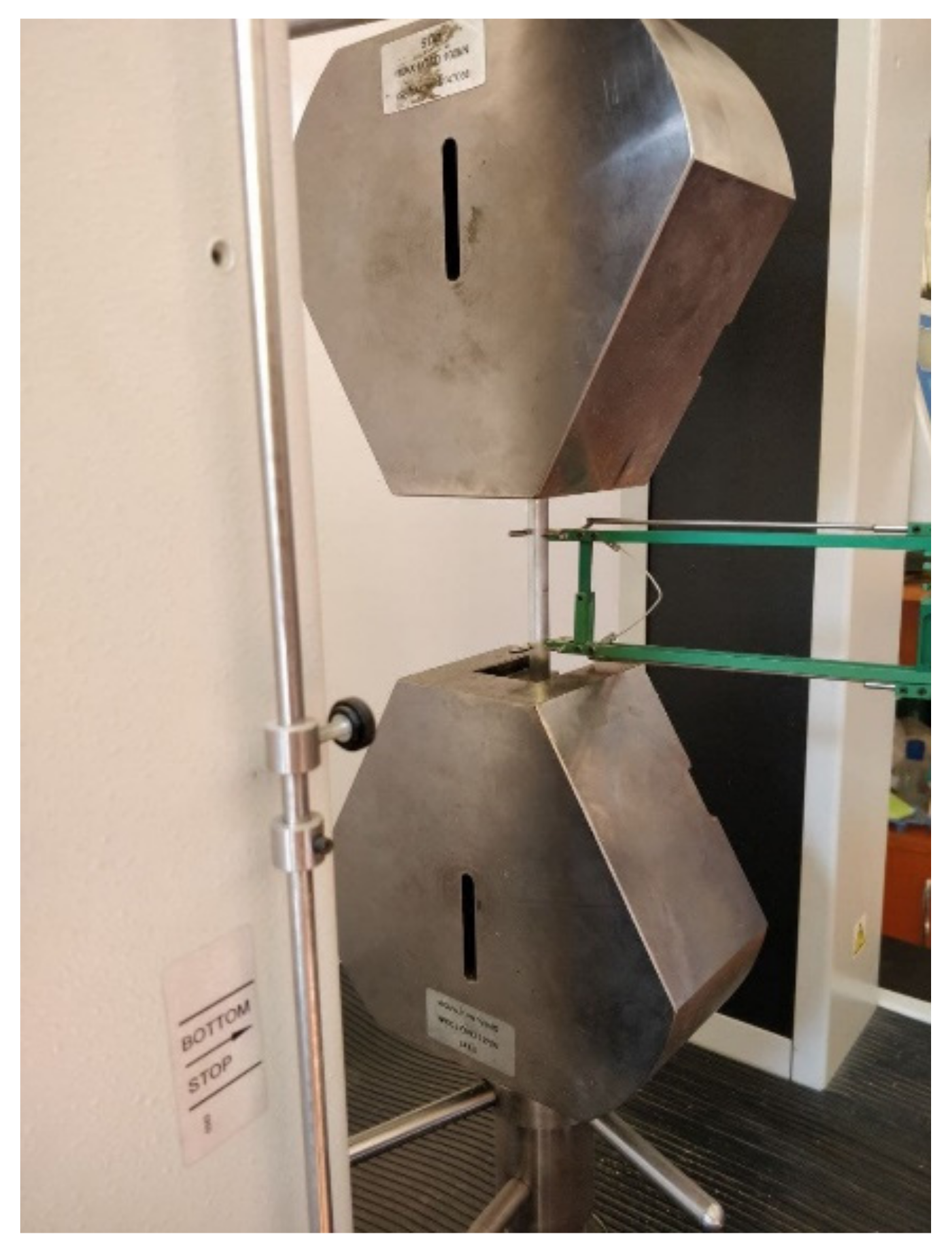

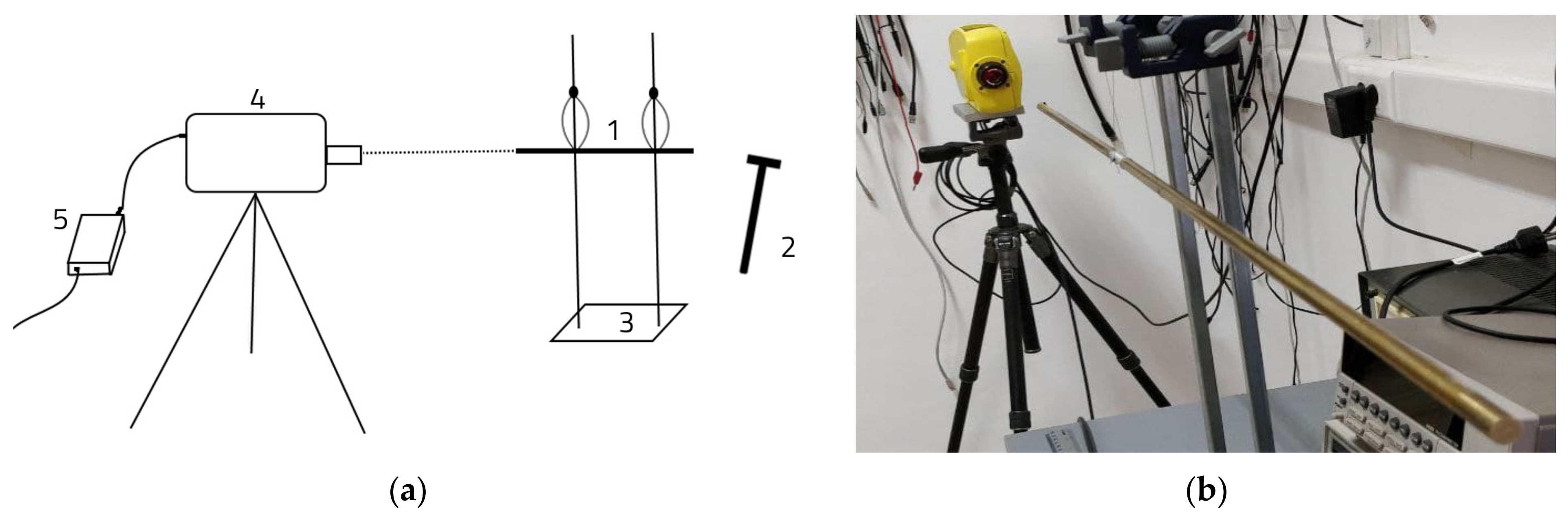

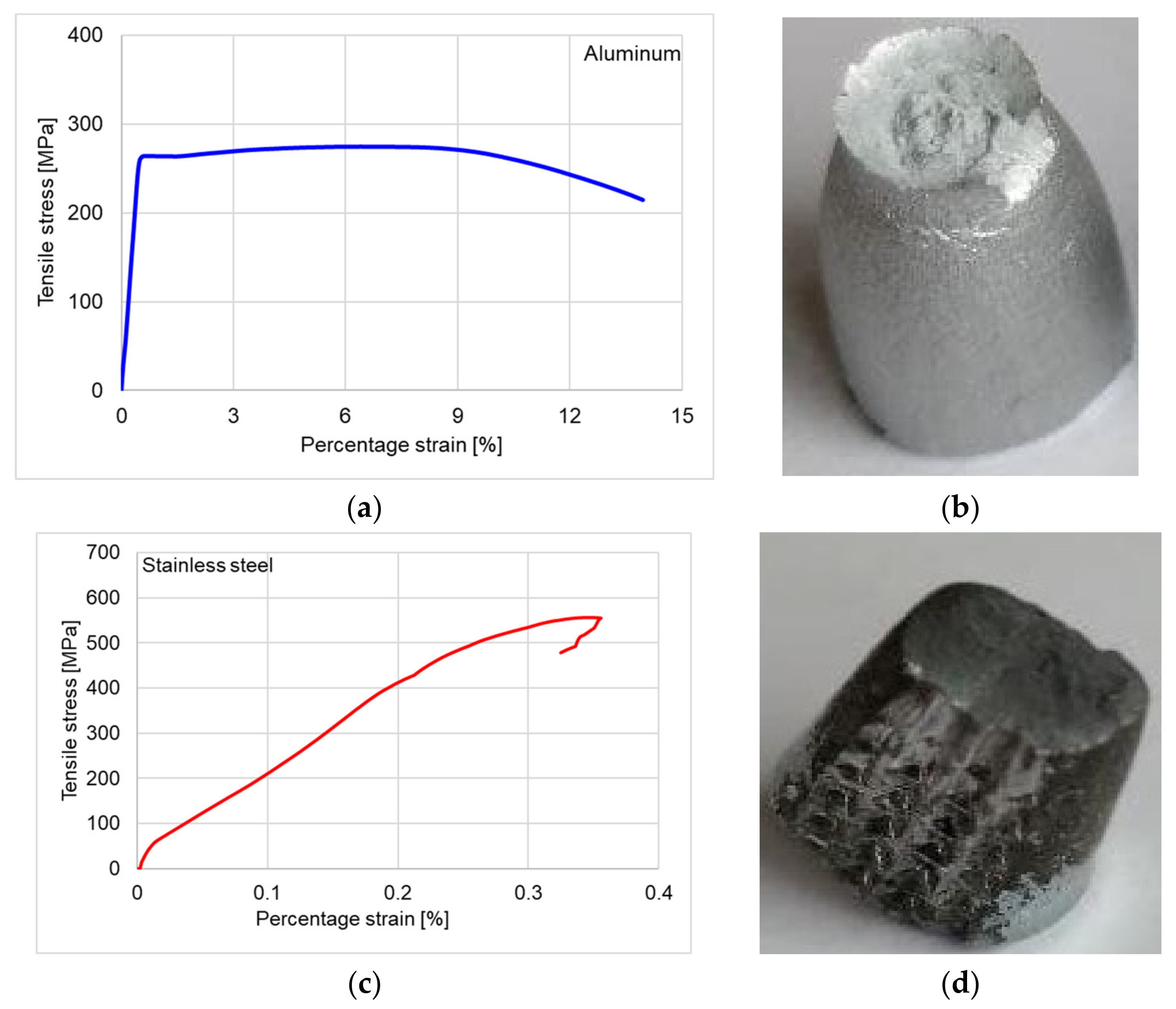
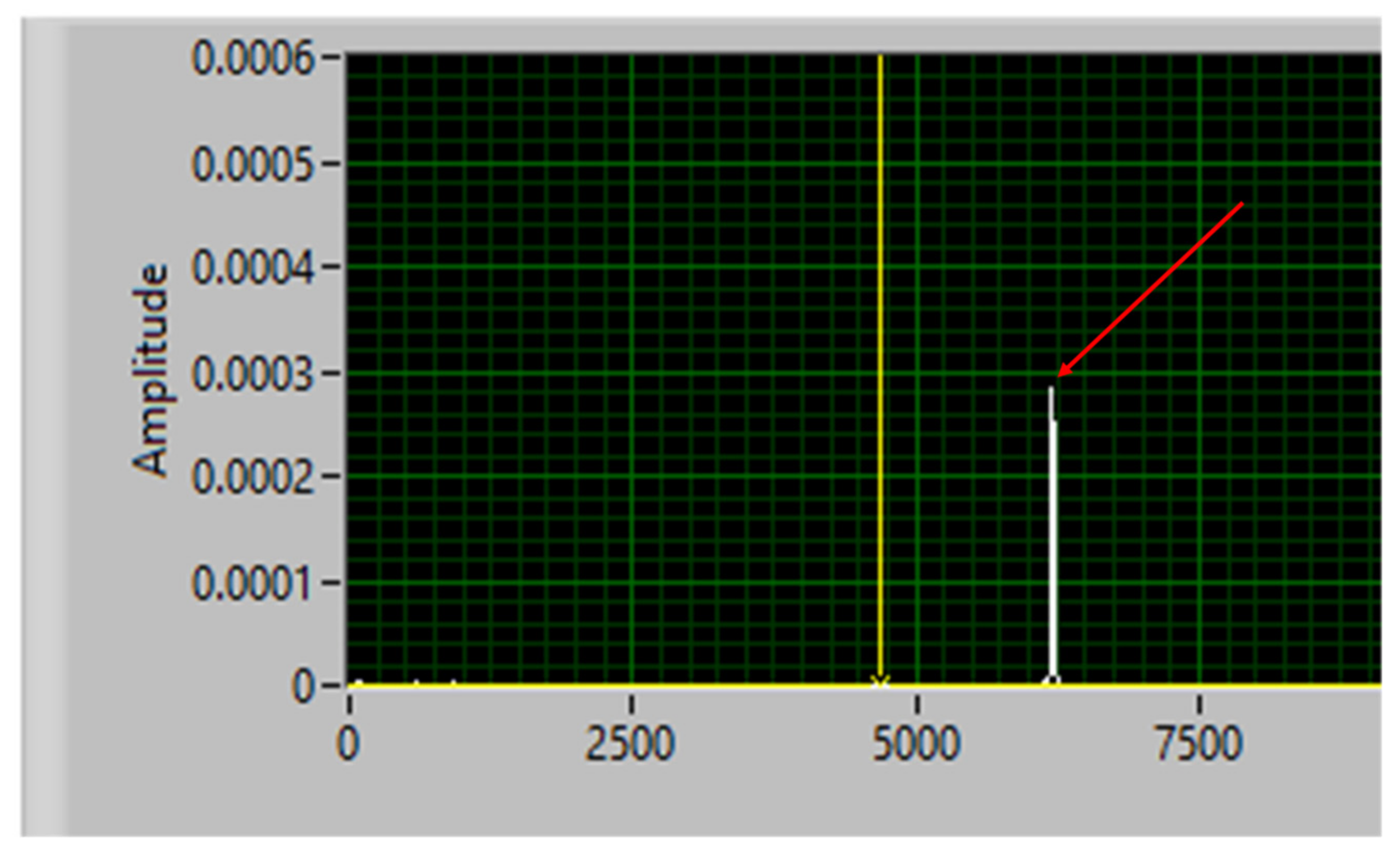

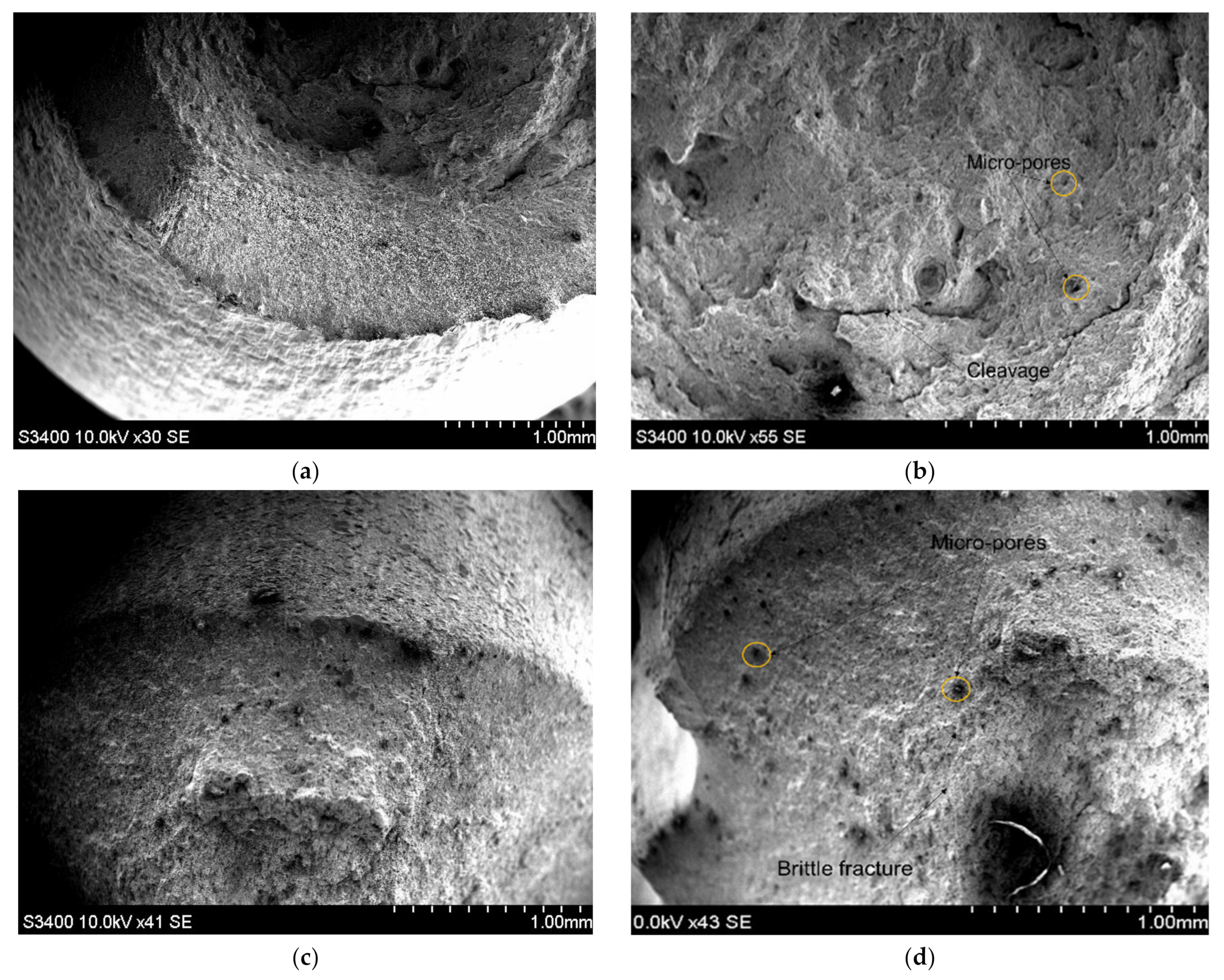

| Type of Material | Length (mm) | Diameter (mm) | Density (kg/m3) | The Experimental Method |
|---|---|---|---|---|
| Aluminum | 182.21 | 9.593 | 2708 | Tensile test |
| Stainless steel | 118.50 | 7.860 | 7818 | Tensile test |
| Aluminum | 40.00 | 9.593 | 2708 | Intrinsic transfer matrix |
| Stainless steel | 40.00 | 7.860 | 7818 | Intrinsic transfer matrix |
| Type of Material | Modulus of Elasticity (GPa) | Tensile Strength (MPa) |
|---|---|---|
| Aluminum | 66 | 273 |
| Stainless steel | 182 | 555 |
| Type of Material | Sound Propagation Velocity (m/s) | Difference % | Modulus of Elasticity (GPa) | Difference % | |||||
|---|---|---|---|---|---|---|---|---|---|
| ITMM | Ref. [27] | ITMM | TT | Ref. [28] | ITMM-TT | ITMM-Ref. [28] | TT-Ref. [28] | ||
| Aluminum | 5089 | 5000 | 1.74 | 70 | 66.59 | 69 | 4.87 | 1.45 | 3.49 |
| Stainless steel | 4889 | 5000 | 2.27 | 186 | 182.12 | 180 | 2.09 | 3.33 | 1.18 |
| Type of Material | Elemental Chemical Composition | ||||
|---|---|---|---|---|---|
| Aluminum | 0.02% C | 1.57% O | 0.96% Mg | 85.44% Al | 0.80% Ca |
| Stainless steel | 0.08% C | 0.47% O | 1.31% Al | 65.66% Fe | 1.84% Ca |
Publisher’s Note: MDPI stays neutral with regard to jurisdictional claims in published maps and institutional affiliations. |
© 2022 by the authors. Licensee MDPI, Basel, Switzerland. This article is an open access article distributed under the terms and conditions of the Creative Commons Attribution (CC BY) license (https://creativecommons.org/licenses/by/4.0/).
Share and Cite
Stanciu, M.D.; Cosnita, M.; Cretu, C.N.; Teodorescu, H.D.; Trandafir, M. Mechanical and Acoustic Properties of Alloys Used for Musical Instruments. Materials 2022, 15, 5192. https://doi.org/10.3390/ma15155192
Stanciu MD, Cosnita M, Cretu CN, Teodorescu HD, Trandafir M. Mechanical and Acoustic Properties of Alloys Used for Musical Instruments. Materials. 2022; 15(15):5192. https://doi.org/10.3390/ma15155192
Chicago/Turabian StyleStanciu, Mariana Domnica, Mihaela Cosnita, Constantin Nicolae Cretu, Horatiu Draghicescu Teodorescu, and Mihai Trandafir. 2022. "Mechanical and Acoustic Properties of Alloys Used for Musical Instruments" Materials 15, no. 15: 5192. https://doi.org/10.3390/ma15155192
APA StyleStanciu, M. D., Cosnita, M., Cretu, C. N., Teodorescu, H. D., & Trandafir, M. (2022). Mechanical and Acoustic Properties of Alloys Used for Musical Instruments. Materials, 15(15), 5192. https://doi.org/10.3390/ma15155192









